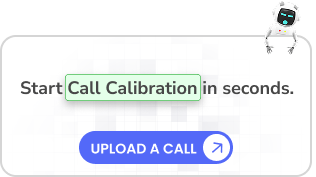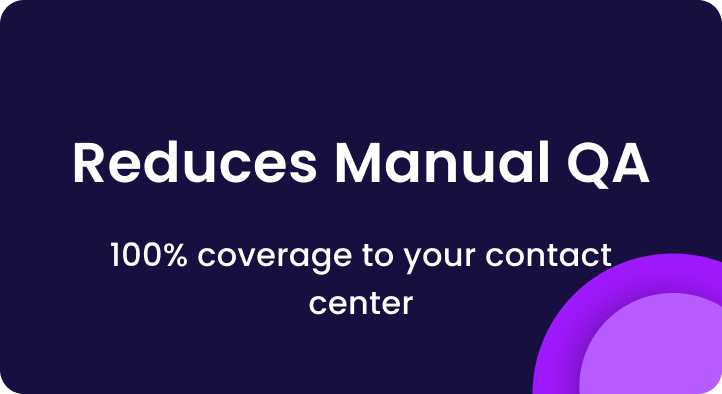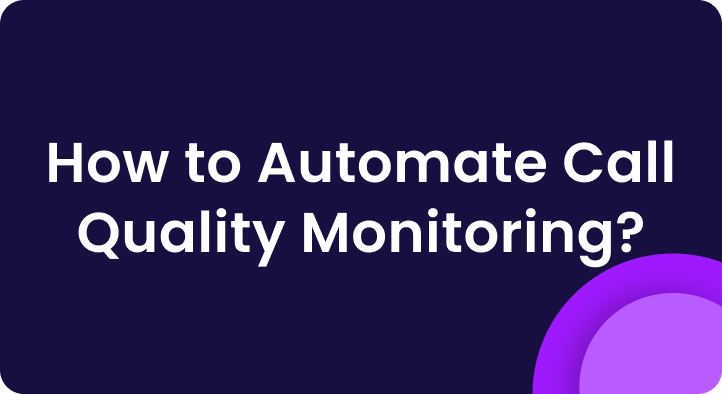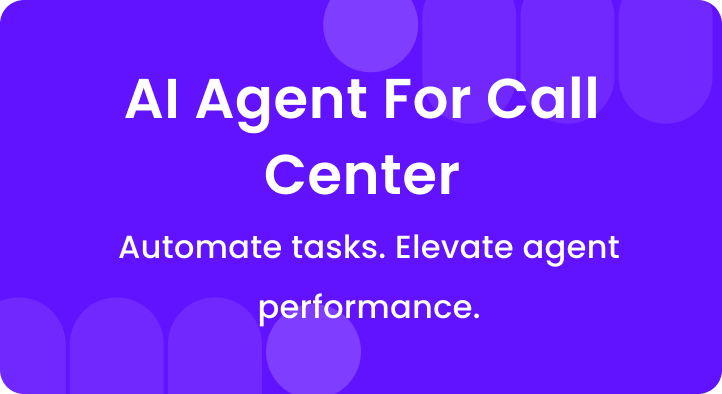Inbound call centers are your brand’s frontline.
One bad call can lose you a customer, so nailing every interaction is a must.
Think about it: nearly 73% of customers say they’ve switched brands because of a poor customer service experience.
Even in a world of chatbots and apps, most people still prefer talking to a real person.
In fact, 53% of customers say speaking to a live agent is their #1 choice.
That’s why quality assurance (QA) is so critical.
This guide shows you why QA matters for your call center’s success and how to get it right using smart, scalable methods.
Let’s dive in!
A. What is quality assurance in a call center?
Quality assurance (QA) in a call center simply means making sure every customer interaction meets your standards.
It’s the process of listening to, evaluating, and improving how your agents handle customer interactions.
The goal? Making sure every chat, call, or email hits your high standards.
- Voice calls: Reviewing recordings to check empathy, accuracy, resolution, and professionalism.
- Chat/email: Reading transcripts to see if responses were clear, helpful, and timely.
- All channels: Ensuring agents follow your scripts (or adapt them smartly!), use the right tools, and leave the customer feeling valued.
For example, you might pick a few live calls or chat transcripts each week and score them: did the agent follow the script? Was the tone friendly? Did they answer the customer’s questions fully?
B. How is quality assurance different from quality control?
Quality Assurance (QA) and Quality Control (QC) are often mixed up, but they’re not the same thing.
Here’s the quick difference:
| Aspect | Quality Assurance (QA) | Quality Control (QC) |
| Approach | Proactive – you stop issues before they surface. | Reactive – you fix issues after they surface. |
| Focus | Build clear processes, scripts, and training. | Inspect calls to spot errors and gaps. |
| Timing | Happens before the customer interaction. | Happens after the customer interaction. |
| Typical Action | Teach agents tone, empathy, and compliance scripts. | Listen to a complaint call to find what went wrong. |
| Ultimate Goal | Ensure every caller enjoys a smooth experience from the start. | Understand failures so they don’t repeat. |
C. Why QA is critical to call center success
Quality assurance is the rocket fuel behind better performance in your call center.
When QA is done well, almost every part of your operation gets a lift.
| Benefit | What Happens | Resulting KPI |
| Higher satisfaction | Consistent, friendly help | ↑ CSAT, ↑ NPS |
| Better first-call resolution | Agents follow proven steps | ↑ FCR, ↓ AHT |
| Risk-free compliance | Scripts & disclosures hit every time | ↓ Fines, ↑ Trust |
| Aligned coaching | Targeted feedback after each audit | ↑ Agent skill |
| Positive culture | Wins get recognized fast | ↑ Retention |
1. Boosts satisfaction and loyalty
Happy customers stay customers.
In fact, 89% of people say they are likely to buy again after a positive customer service experience.
Conversely, poor service drives people away.
Studies show nearly three-quarters will jump ship after one bad call.
By auditing calls and improving service quality, QA directly raises your CSAT scores and keeps customers coming back.
2. Improves first call resolution (FCR)
QA helps you spot why calls might need follow-ups.
By reinforcing best practices (like troubleshooting steps and product knowledge), agents resolve issues faster on the first try.
A good QA scorecard allows you to track critical metrics such as first-call resolution, average handle time, and compliance.
In practice, that means you can tie QA to real goals.
For example, weighting your QA criteria to reward quick, correct resolutions (giving more points for FCR).
3. Enables better coaching and consistency
QA pinpoints performance gaps.
A well-designed QA program highlights exactly what an agent did well or missed on a call.
For instance, scorecards let you “identify specific areas where agents excel or fall short,” enabling targeted coaching.
This keeps every agent on the same page, so customers get a consistent experience across the board.
When your whole team knows what “great service” looks like, performance quickly improves overall.
4. Ensures compliance and reduces risk
In regulated industries (finance, healthcare, etc.), even a small slip can be costly.
A strict QA process catches compliance issues before they become violations.
For perspective, one report notes that PCI DSS non-compliance fines range from $5,000 to $100,000 per month.
QA helps you avoid those nightmares by making sure credit card disclosures, privacy statements, and legal scripts are handled correctly on every call.
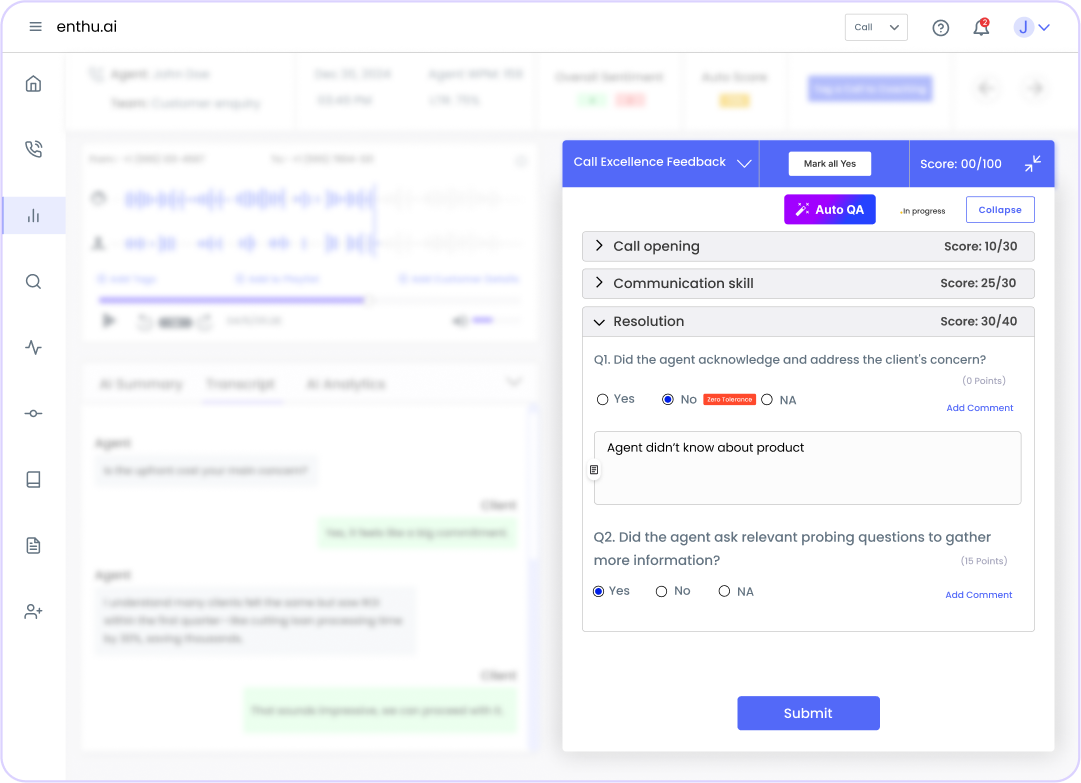
5. Works across omnichannel and remote agents
Today’s customers switch between phone, chat, email, and social.
QA ensures quality everywhere.
Leading platforms now let you record and analyze interactions across all channels in one place.
Likewise, your workforce is changing: Gartner predicts the number of remote call center agents will grow 60%.
Good QA keeps standards high even when agents work from home.
You can monitor chats and emails just as easily as phone calls.
Modern QA tools (like AI-driven software) automatically handle these channels, so you never lose visibility.
6. Drives agent engagement (recognize & reward)
Finally, QA isn’t just about finding faults it’s also about celebrating wins.
Use QA to catch great calls and acknowledge agents often.
Simple praise or rewards make a big difference.
Gallup finds that teams that are regularly praised or given incentives are more productive and loyal.
Recognizing high scores or sharing “customer success stories” shows agents that quality matters.
This positivity fuels motivation and keeps your best people around longer.
D. Common QA gaps and how to fix them
Even the best teams run into QA hiccups.
Here are some familiar gaps and quick fixes you can apply right away:
| Gap | Why It Hurts | Quick Fix |
| Inconsistent scoring | Agents doubt fairness | Monthly calibration sessions |
| Tiny audit sample | Blind spots everywhere | AI tools to audit 100 % |
| No coaching loop | Scores don’t change behavior | 1-on-1 reviews with call clips |
| Wrong metrics | Time spent on trivia | Weight form to CSAT/FCR |
1. The problem: Inconsistent scoring
If two reviewers hear the same call but give different scores, your QA loses credibility.
The fix:
Calibrate and clarify. Make sure every scorecard question has a clear definition and example.
Defining clear criteria (what exactly earns a “pass” or “fail”) and holding regular calibration sessions so all graders stay on the same page.
This alignment cuts confusion and ensures fairness.
2. The problem: Tiny audit sample (1–2% of calls):
Many centers only review a handful of calls per agent per month, missing most interactions. That means many issues slip by unseen.
The fix:
Automate your QA. As one analysis warns, manual QA often covers just 1–2% of calls. By contrast, AI-powered QA tools can review every call for you.
For example
Platforms like Enthu.AI let you analyze 100% of calls easily.
Even if you can’t review every call, use smart sampling rules: auto-pull calls from different days, shifts, customer types and scenarios for a balanced view. This ensures your sample isn’t biased.
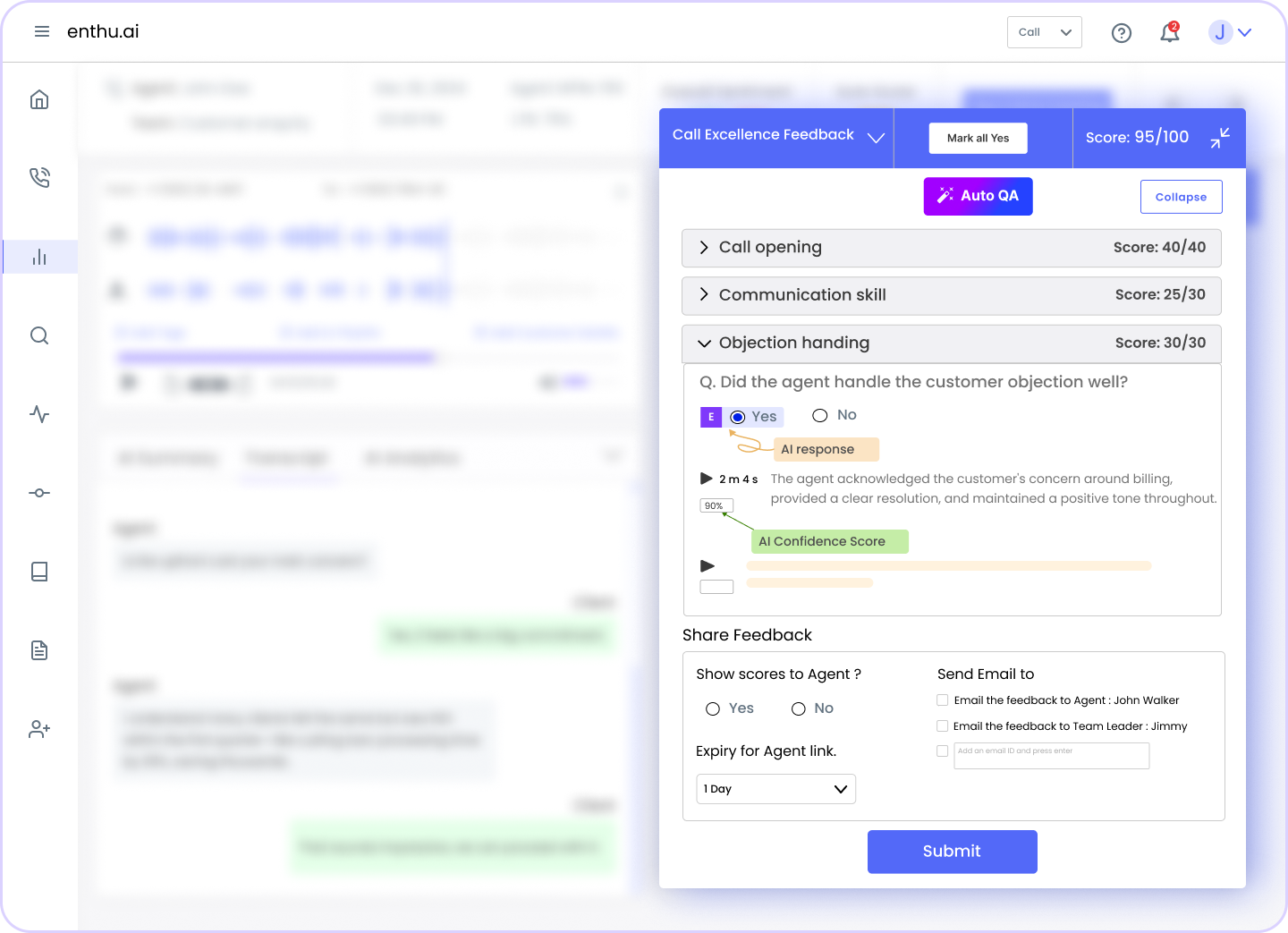
3. The problem: No coaching loop
Another gap is stopping at just scoring. Giving a thumbs-up or a score without follow-up leaves agents unclear on how to improve.
The fix
Connect QA to training. Make QA feedback actionable.
For example
Always pair each score with examples and schedule a one-on-one coaching session to discuss the results. Show the agent the actual call or transcript, point out a strong moment, and one improvement area.
This concrete feedback (with real audio to replay) makes training meaningful. Without this, QA results sit on a shelf. With it, they drive real skill growth.
4. The problem: Misaligned metrics
Sometimes QA focuses on the wrong things (like enforcing scripts) while neglecting what your business truly values.
The Fix:
Fix this by aligning QA with your KPIs. If first-call resolution or upsell rate is a priority, build those into your QA scorecard.
You should “assign higher weights to KPIs that are critical to your business goals, such as first-call resolution or compliance adherence”.
For example
If FCR is huge for your support team, make sure your QA form rewards call resolution steps. When QA mirrors your targets (CSAT scores, legal compliance, etc.), agents see the bigger purpose.
E. How to strengthen your QA program
To take your QA program from “good” to great, focus on practical improvements and team buy-in:
1. Build tailored scorecards
Don’t use a generic checklist.
Create QA scorecards that fit your actual workflows.
For example
Calabrio recommends separate scorecards for different channels or scenarios.
A phone-call QA form might include sections on call opening, issue resolution, and closing, while an email QA form checks for timely response, clarity, and tone.
Make sure each question is clear and tied to a desired outcome in the customer journey.
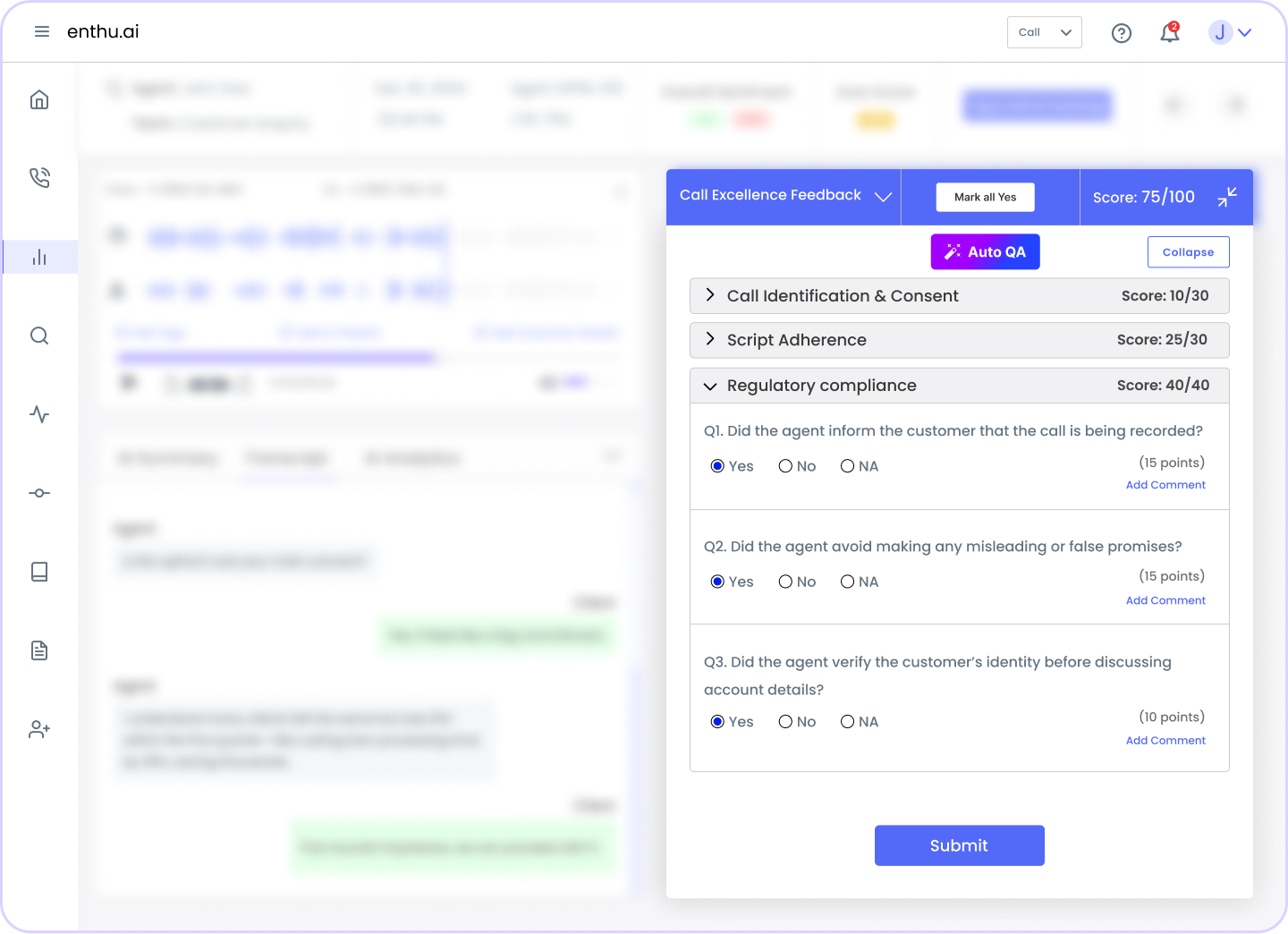
2. Use AI and automation to scale
Scale your QA with technology so you’re not limited by hours in a day.
AI-driven QA tools (like Enthu.AI) can automatically transcribe and evaluate calls at scale.
They’ll surface trends – for instance, common words or sentiment shifts that humans would miss.
Remember, as one expert put it: “Automate repetitive parts of the QA process, such as call transcription and initial scoring”.
This frees your team to focus on deep coaching instead of endless listening.
3. Connect QA to coaching
Make sure QA isn’t a report you file away.
- After each audit, share insights with agents.
- Review call excerpts, discuss what went well and what could improve.
- Schedule one-on-one coaching sessions to review QA scores and set goals.
- Use a collaborative approach – ask the agent what they think went well or could improve.
This keeps agents engaged in the process and turning feedback into action.
4. Calibrate with your team
Involve team leads and supervisors in QA reviews and training.
Hold regular calibration meetings so everyone uses the scorecard the same way.
This not only ensures consistency, but it also makes QA a team effort.
When agents see that team leads care about QA and use the same standards, they take the process seriously.
Plus, fresh eyes (like a lead joining a review) can catch things a single QAE might miss.
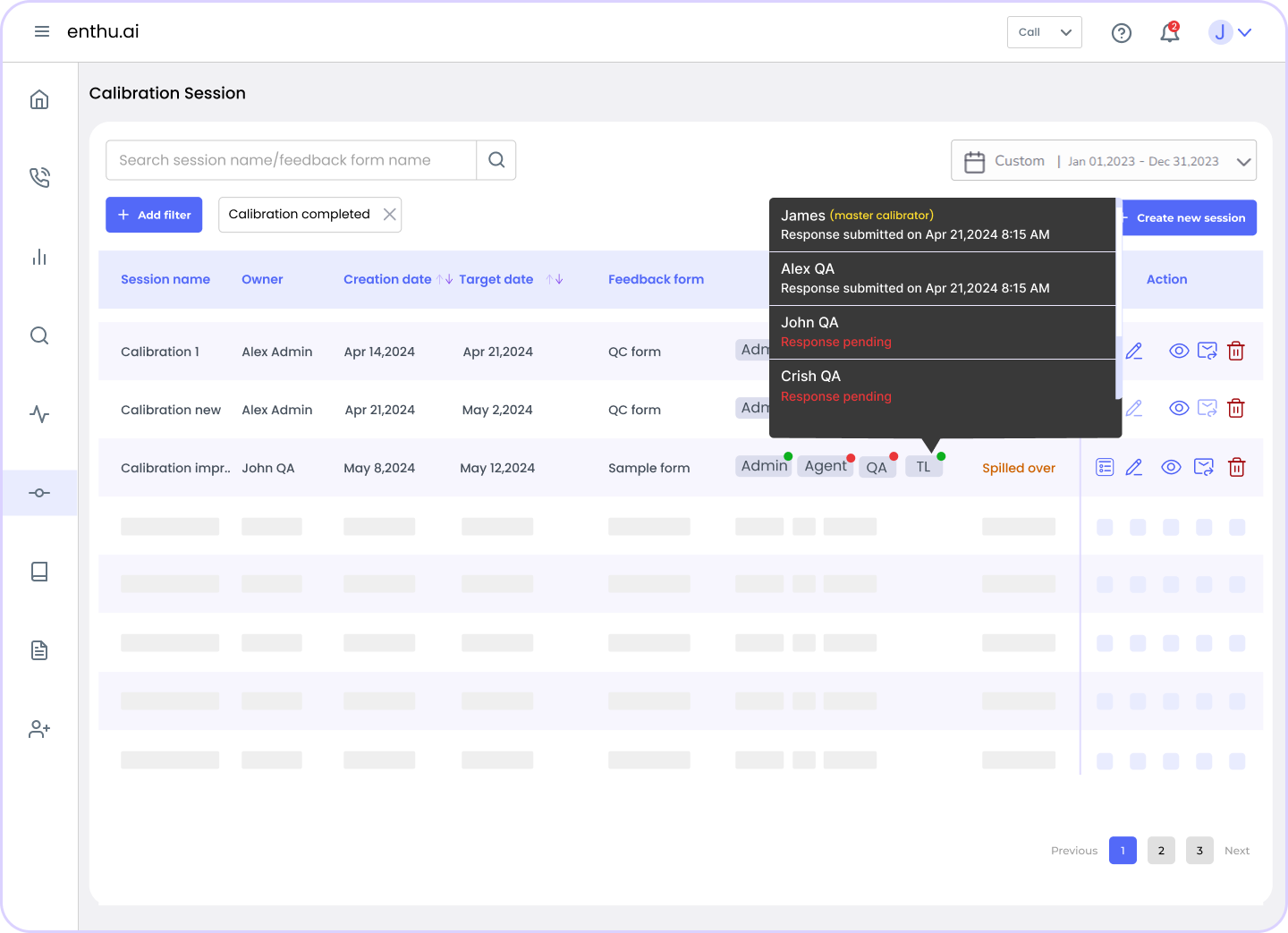
5. Recognize and reward excellence
Finally, make QA fun by celebrating success.
Use your QA program to spot star agents and shout them out.
Simple praise for a “QA score of the week” or small rewards for high-quality calls go a long way.
Studies show that recognizing good performance, even just praising team members, increases productivity and fosters loyalty.
Share success stories and let peers congratulate each other.
This positive reinforcement encourages everyone to hit high standards.
Conclusion
Quality assurance isn’t a buzzword; it’s the foundation of a high-performing call center.
A single bad call can drive away a customer, while consistently great calls build loyalty and revenue.
With a smart QA program, you’ll boost CSAT and retention, improve first-call resolution, keep agents on track, and avoid costly compliance slip-ups.
The key is to use QA not as a blame game, but as a coaching and improvement tool.
- Build QA scorecards that match your workflows,
- Review calls (ideally with AI) to cover more ground,
- Tie every score back to training.
- Involve your leads, celebrate wins, and keep refining your approach.
The payoff is huge: happier customers, a more effective team, and a call center that truly drives growth.
FAQs
1. What is the importance of QA in a call center?
QA keeps every call on brand and helpful. You spot errors early and coach agents fast. That lifts CSAT, retention, and revenue without extra head-count. It also shields you from costly compliance slips.
2. Why is quality assurance becoming more important?
Customers expect quick, flawless help on every channel. Social media now amplifies mistakes in minutes. Remote teams and AI need tighter oversight than before. QA gives you data to adapt fast and stay competitive.
3. What is the role of a quality analyst in a call center?
A quality analyst scores calls, chats, and emails daily. They flag trends, root causes, and compliance gaps. They coach agents with examples and set clear goals. Their insights drive training, process fixes, and customer wins.


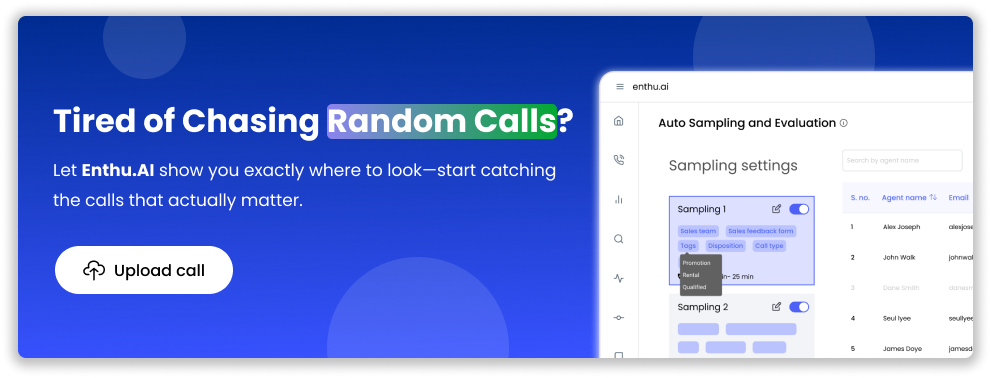

 On this page
On this page